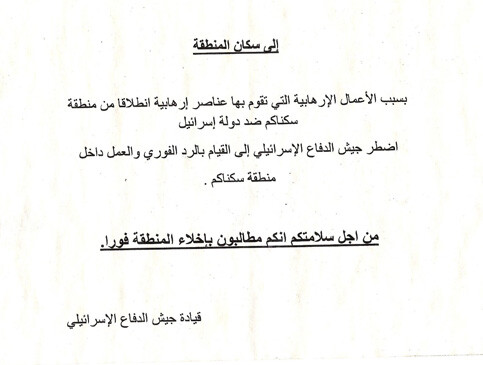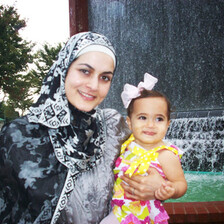Durham, United States 9 January 2009

The flyer being dropped on Gaza by Israeli forces.
“You don’t know anymore; you don’t know who is alive, you feel you are in a trap, you don’t know who is a target,” said my friend and neighbor in Gaza City, journalist Taghreed El-Khodary. The fear resonated in her voice while she was on the phone to Al-Jazeera. Taghreed lives on a street near my parents.
“Where to? Where can I go seek refuge to?” she continued. “I live next to the parliament which was destroyed; next to the police station, which was destroyed; next to the hospitals, which were bombed; and the Israeli navy is shelling from the sea, the F-16s from the sky, the tanks from the ground … where to?” she repeated again and again.
“First your house shakes, and the windows break, and the fear … the fear. And when you see all these children around you in the hospital. Some can draw, and what they drawing is unbelievable. A six-year-old boy in my house drew a picture of boy who was alive, and another who was dead. He said the dead boy was his friend, whom the Israelis killed. And the father is unable to protect his child. And the mothers are trying to hide their fear from their kids.”
My father today said more flyers were dropped in a bid to intimidate and terrorize an already bludgeoned, starved, and terrified population.
“To residents of the area,” read the flyer, which my father scanned and emailed me.
“Due to the terrorist activity that terrorist elements are carrying out from your residential area against the State of Israel, the Israel Defense Force has been forced to respond immediately and operate in your residential area … you are ordered to leave the area immediately.”
Taghreed received a copy too, courtesy of your friendly neighborhood occupying army.
“They are dropping them everywhere — and everyone thinks it’s their area being targeted, but in reality, no one knows. And even if they were to leave, where do they go to? To another area where flyers were dropped and where bombs are falling? It’s a tactic to induce terror and intimidation,” my father told me.
For the first time in weeks, they had a few hours of precious electricity today. And things felt “normal” for a while, as they basked in the glow of electrical light and their fridge hummed to life. They took the opportunity to chat with me on Skype. They wanted to talk to me hour after hour, all morning my time, about nothing in particular, before they were immersed in the dark and terror once again.
After speaking to his grandfather, my son Yousuf looked at me and asked in the inquisitive, matter-of-fact way that he usually inquires about all things small and big in this world, “mama — why don’t the Israeli soldiers think before they shoot people?”
“Because they don’t think like you, habibi.”
Early in the day, the United Nations agency for Palestine refugees (UNRWA) said it would stop operations after an aid convoy came under direct Israeli attack, and two UN drivers were killed by Israeli shells.
In the afternoon, my father learned that a family living in Gaza’s Zeitoun neighborhood — the Samuni clan — who had already lost dozens of members in previous days, lost an additional 70. Paramedics from the Red Cross were finally able to reach them after days of being prevented from doing so by Israeli forces discovered bloated rotting corpses, and four children clinging to life, lying limp and emaciated from hunger but alive near their slaughtered mother.
Head of the Red Cross, Pierre Wettach accused Israel of deliberately ignoring the besieged, dying family: “The Israeli military must have been aware of the situation but did not assist the wounded. Neither did they make it possible for us or the Palestine Red Crescent to assist the wounded.”
Laila El-Haddad is a Palestinian freelance journalist, photographer, and blogger (http://a-mother-from-gaza.blogspot.com/) who divides her time between Gaza and the United States.
Related Links





